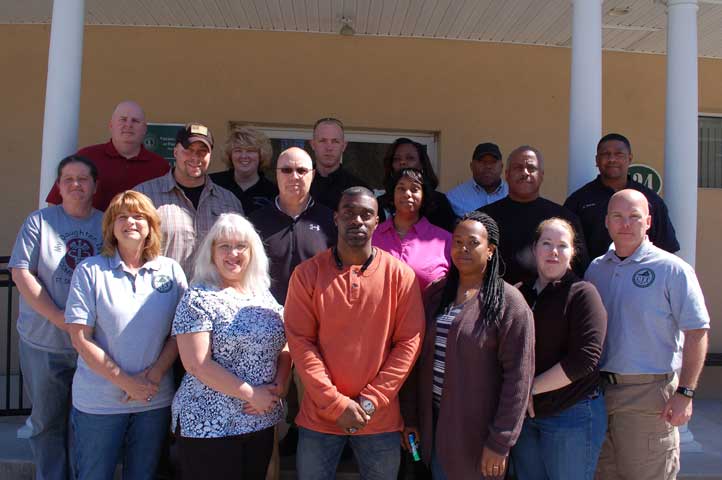Crossroads CIT efforts progress
Published 12:43 pm Thursday, April 7, 2016

- Pictured are, from left, front row, Karla Ellington, Crossroads CSB; Tyra Bowman, Piedmont Correctional; Calvin Walker, Prince Edward County Sheriff’s Office; Felicia Martin, Buckingham Correctional; Andrea Teague, Steadfast Security; Joe Burton, CIT Trainer; second row, Anastasia Webber, Buckingham Correctional; Brian Warner, Halifax Police Department; Mike Driskill, Farmville Emergency Communications; Coretta Booker, Buckingham Correctional; Delbert Dove, Prince-Edward County Sheriff’s Office; Garry Hardy, Farmville Police Department; third row, Scott Earhart, Southside Virginia Community College/Charlotte County Sheriff’s Office; Jackie Gilbert, Farmville Emergency Communications; Dustin Brown, Charlotte County Sheriff’s Office; Tanya Morris, Buckingham Correctional; and Robert Goldman, Prince Edward County Sheriff’s Office. Not pictured is Antoinette Barnes, Buckingham Correctional.
The Crossroads Community Services Board has seen its first class complete 40-hour, five-day Crisis Intervention Team training.
The program is a major undertaking and one that is part of a movement intended to change how the mentally ill are perceived and how authorities interact with them.
CIT training is designed to educate law enforcement officers and other responders on how to “effectively and humanely” interact with a person with a mental illness, and connect them with assistance programs instead of simply incarcerating them, said Joe Burton, the program’s coordinator for Crossroads.
“CIT skills are an additional tool that assists officers as they respond to situations involving individuals who are in psychiatric crisis,” he said.
“These calls have the potential to become high risk.”
Sixteen people may have completed the full 40-hour, five-day curriculum approved by the Virginia Department of Criminal Justice Services, but 29 law enforcement officers, nine dispatchers and 10 from other institutions have had some training.
“We are definitely progressing well,” said Burton, who is also a former policeman in Henrico.
Training is comprised of classroom instruction and practical exercises delivered by mental health professionals, experts in other respective mental health fields, and CIT-trained first responders, he said.
The goal is to train at least half of each law enforcement department in the Crossroads service area of Amelia, Buckingham, Charlotte, Cumberland, Lunenburg, Nottoway and Prince Edward.
The objective is to eventually have a sufficient number of officers, deputies, fire and rescue workers, dispatchers, corrections officers, mental health workers and other pertinent community members trained to ensure that CIT-trained personnel are available at all times.
“We need to stop the revolving door,” Burton said. “Individuals suffering from mental illness do not get better by being incarcerated.”
Crossroads has received a $15,000 grant that allows Burton to go out into the various localities and do the five-day training. He also wants to train volunteer firefights, Emergency Medical Services personnel, and he would like to provide training for nurses, too.
Ultimately, a receiving center will be developed to centralize all the services. Crossroads is applying for a grant to pay for it.
“The receiving center is really what is going to pull all this together,” Burton said.
The effort grew out of the 1987 shooting death of 27-year-old Joseph Dewayne Robinson, who was wielding a knife during the confrontation in which he was killed by the Memphis, Tenn., Police Department. The incident prompted the development of CIT the next year, and since then it has gone nationwide and now worldwide, used in Canada, New Zealand, Australia and England.
The officer’s safety and that of the citizens and everyone else is paramount, and CIT can’t be applied in every situation, Burton acknowledges.
“I always tell them, ‘This is just another tool in your toolbox,’” Burton said. “If you can use it, use it. If not, use some of your other training.”
But, Burton advocates for CIT from experience.
“I know it works because I used it on the street,” he said.
Burton admits that for some of his 14 years in law enforcement, “I was one of those officers who was afraid of dealing with someone in mental illness crisis.”
The options: Arrest them or drive them where they wanted to go.
After receiving the training, Burton said he encountered a woman who refused to stop for him.
When she finally did, he could tell she was in distress. Instead of making a felony stop, he just talked to her.
He ended up calling her doctor, who told him that he was scheduled to see her the next day and asked that she be allowed to just go. Burton complied.
“It just worked better,” he said. “Had I not gone through this training, I don’t know how I would have handled that.”
This training helps officers more timely and effectively assess whether the person is in need of mental health assistance, and provides officials with the skills to de-escalate the situation until it can be turned over to the appropriate personnel.
“CIT is about acting, not reacting,” Burton said.
A term used to identify people who are receiving services has changed over the years from patient to client.
“The word consumer allows for individuals to have a choice about their treatment, and become active participants in their therapy, and recovery,” Burton said.
Some of the things officers learn: Be positive; respond to people as individuals; learn about the person and work with them based on knowledge rather than assumptions; do what you can to facilitate assistance; don’t ever allow false statements about mental illness to go unchallenged.
Officials know that the efforts are being successful because injuries to officers and citizens have decreased, as has the amount of litigation arising from such confrontations against law enforcement, Burton said.
Fewer tactical team call-outs are made, and arrest rates — along with the number of incarcerated and the volume of cases on court dockets — are down, he said.
“You develop a bond, a form of trust with the consumer, and they know that no matter what, they can find you and you will know how to get them the help they need and deserve.”





